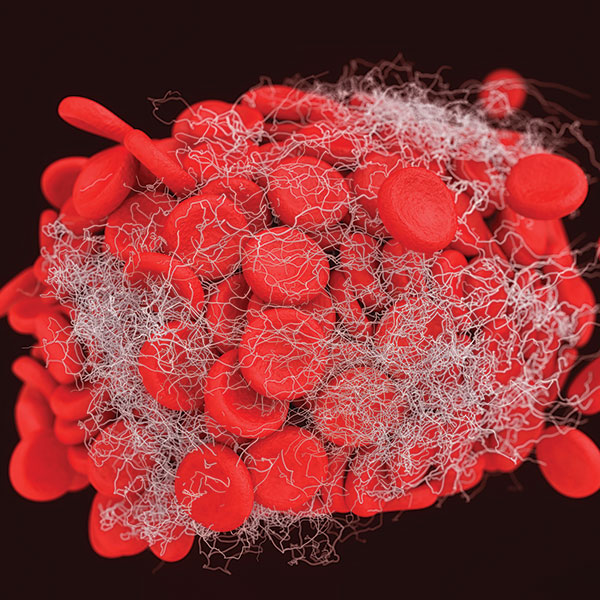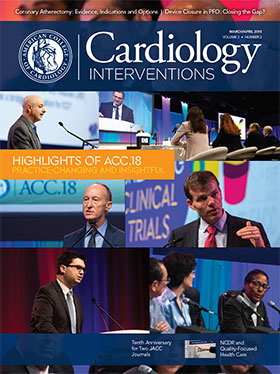Journal Wrap | The Hottest Research From Various Peer-Reviewed Journals
The hottest research from various peer-reviewed journals.
Thromboembolic Risk in AFib After CABG

New-onset postoperative atrial fibrillation (POAF) in patients who had undergone CABG was associated with a lower long-term thromboembolic risk than that of patients who had nonvalvular atrial fibrillation (NVAF), according to a recent study in JAMA: Cardiology.
Jawad H. Butt, MD, et al., used data from a clinical cardiac surgery database and Danish nationwide registries to identify patients undergoing first-time isolated CABG surgery who developed new-onset POAF between January 1, 2000 and June 30, 2015. A total of 2,108 patients with POAF were matched (1:4 ratio) by age, sex, CHA2DS2-VASc score and year of diagnosis with 8,432 nonsurgical NVAF patients. Read more >>>
In the POAF group, oral anticoagulant (OAC) therapy was initiated in 175 patients (8.4 percent) within 30 days (83 percent received warfarin). Antiplatelet therapy was initiated within 30 days after discharge in 78.9 percent of patients receiving OAC and in 79.7 percent of patients not receiving OAC. In the NVAF group, OAC was initiated in 3,549 patients (42.9 percent) within 30 days (78 percent received warfarin).
The rate of thromboembolism in the POAF vs. NVAF groups was 18.3 vs. 29.7 events per 1,000 person-years. POAF was associated with a significantly lower risk of thromboembolism compared with NVAF (adjusted hazard ratio [HR], 0.67; pp<0 .001). OAC therapy was associated with a significantly lower risk of thromboembolic events in both groups compared with patients who had none.
The rate of all-cause mortality in the POAF vs. NVAF groups was 46.9 vs. 88.0 events per 1000 person-years. POAF was associated with a significantly lower risk of all-cause mortality compared with NVAF (adjusted HR, 0.55; pp< 0.001). OAC therapy during follow-up was associated with a significantly lower risk of all-cause mortality in patients with NVAF (adjusted HR, 0.51; p<0 .001) but not in patients with POAF (adjusted HR, 1.09; p=0.56) compared with patients who had no OAC therapy.
“Developing new-onset POAF after CABG surgery was associated with a lower long-term thromboembolic risk compared with NVAF,” the authors conclude. “Further, patients with POAF did not have significantly higher associated risk of thromboembolism compared with those who did not develop POAF after CABG surgery. These data do not support the notion that POAF should be regarded as equivalent to primary NVAF in terms of long-term thromboembolic risk.”
Butt JH, Xian Y, Peterson ED, et al. JAMA Cardiol 2018;Mar 28:[Epub ahead of print].
Research Shows Home-Based Cardiac Rehab Increases Participation

Home-based cardiac rehab programs may be an effective tool for increasing cardiac rehab participation among patients hospitalized with ischemic heart disease (IHD), according to a research letter published in JAMA Internal Medicine.
David W. Schopfer, MD, MAS, et al., conducted a six-year study to compare cardiac rehab participation in 99,097 patients hospitalized for IHD across three groups of facilities: off-site facility-based cardiac rehab programs reimbursed by the Veterans Health Administration (VHA); either off-site cardiac rehab or VHA on-site cardiac rehab programs; or off-site cardiac rehab, VHA on-site cardiac rehab or home-based cardiac rehab programs. Participation was defined as partaking in at least one outpatient cardiac rehab session within 12 months after the patient’s discharge date. Read more >>>
Results showed that participation increased from 6.0 percent to 24.6 percent at the 12 facilities that implemented home-based cardiac rehab programs. And from 10.9 percent to 17.6 percent at the 23 facilities that offered referral to off-site cardiac rehab or VHA on-site cardiac rehab. There was no obvious change in cardiac rehab participation at the 52 facilities that offered referral to off-site cardiac rehab only (from 6.4 percent to 6.6 percent).
Furthermore, in a sensitivity analysis that required three or more cardiac rehab sessions, participation increased from 5.1 percent to 16.6 percent at facilities that offered home-based cardiac rehab; from 8.3 percent to 9.6 percent at facilities that offered off-site or VHA on-site cardiac rehab; and from 5.2 percent to 6.0 percent at facilities that offered off-site cardiac rehab only.
The authors also found that patients offered home-based cardiac rehab were less likely to drop out after the first session than those for whom home-based cardiac rehab was not available (16.8 percent vs. 20.2 percent).
“We recognize that results may be biased because facilities that developed home-based cardiac rehab programs were likely to be stronger proponents of cardiac rehab, and overall cardiac rehab participation remained low,” the authors concluded. “Nonetheless, these findings demonstrate that home-based cardiac rehab may be an effective tool for increasing cardiac rehab participation among patients who would otherwise decline to participate.”
Schopfer DW, Krishnamurthi N, Shen H, et al. JAMA Intern Med 2018. Jan 22:[Epub ahead of print].
Barbershop-Based Intervention Leads to Blood Pressure Reductions in African-American Men

A unique study that combined barbershop-based health outreach with the delivery of care onsite by a specialty-trained pharmacist resulted in significantly lower blood pressure in African-American men after just six months. The study was presented by Ronald G. Victor, MD, FACC, at ACC.18 and published simultaneously in the New England Journal of Medicine.
Researchers recruited 319 African-American men ages 35 to 71 years whose baseline systolic blood pressure was >140 mm Hg from 52 Los Angeles County barbershops. Of the 309 men who completed the study, 132 were randomly assigned to receive monitoring and medication management from a pharmacist (intervention group) and 171 to receive encouragement from their barber on lifestyle recommendations and making doctor appointments (control group). Pharmacists measured blood pressure and monitored plasma electrolyte levels for men in the intervention group. The primary outcome was reduction in systolic blood pressure at six months; the secondary outcome was reduction in diastolic blood pressure. Read more >>>
After six months, 64 percent of men in the intervention group had blood pressure in the normal range, compared with just 12 percent of the control group. In the intervention group, systolic blood pressure decreased from 153 mm Hg at baseline to 126 mm Hg, and diastolic blood pressure decreased by 18 mm Hg. In contrast, in the control group, systolic blood pressure decreased from 155 mm Hg to 145 mm Hg, and diastolic blood pressure dropped by 4 mm Hg.
At baseline, about one-half of participants in both groups were taking at least one blood pressure medication. After six months, 100 percent of those in the intervention group and 63 percent of those in the control group were taking blood pressure medications.
Researchers are now studying whether the effects are sustained for an additional six months. They hope to expand the program to other parts of the country. “By bringing state-of-the-art medicine directly to the people who need it on their home turf, in this case in a barbershop, and making it both convenient and rigorous, blood pressure can be controlled just as well in African-American men as in other groups,” Victor said. “If this model was scaled up and sustained, millions of lives could be saved, and many heart attacks and strokes could be prevented.”
Victor RG, Lynch K, Li N, et al. N Engl J Med 2018;March 12:[Epub ahead of print].
CARES: Increased Risk of Death With Febuxostat in Patients With Gout and CV Disease
The gout drug febuxostat was shown to be noninferior to allopurinol for the primary outcome of the combined rate of fatal and nonfatal adverse events in patients with gout and established cardiovascular disease, according to results of the CARES trial. However, for the secondary endpoint of death from cardiovascular or any cause, there was a significantly increased risk. The trial, mandated by the U.S. Food and Drug Administration when the drug was approved because of a signal of an elevated risk of adverse cardiovascular events in early clinical trials, was presented by William B. White, MD, at ACC.18 and simultaneously published in the New England Journal of Medicine. Read more >>>
The median follow-up was 32 months (and as long as 6.5 years) in the 6,190 patients (84 percent men). The rate of the composite primary outcome (consisting of cardiovascular death, nonfatal myocardial infarction, nonfatal stroke or urgent revascularization due to angina) from the time from study drug randomization to first occurrence was similar in both treatment groups, meeting the study’s threshold for noninferiority of febuxostat to allopurinol.
However, there was a potential signal for increased mortality with febuxostat compared with allopurinol in the analysis of the individual endpoint components, with a 34 percent higher rate of death from cardiovascular causes and a 22 percent higher rate of death from any cause. Mortality rates with febuxostat and allopurinol were similar among the 50 percent of patients with a history of chronic kidney disease.
Approximately 45 percent of patients discontinued febuxostat before the study ended. Although the elevated risk of death was diminished in these patients, overall more patients died after stopping their assigned study drug than while taking it.
The increased risk of death was consistent across subgroups. Among patients receiving febuxostat, there was a higher risk of death in patients who did not regularly take aspirin and those who regularly took nonsteroidal anti-inflammatory drugs (NSAIDs), compared with those taking aspirin or not taking NSAIDs. Yet, researchers caution that CARES was not designed to assess potential medication interactions.
“It is important to be careful when interpreting these findings; it doesn’t necessarily indicate there’s an interaction between these drugs and febuxostat,” White said. “It might have been that these patients had more active gout with more flares, for example.”
The investigators were not able to determine the reason for the surprising results and plan to further examine the data for insights into the optimal treatment for gout in patients with both cardiovascular disease and kidney disease. Ongoing studies in Europe are evaluating the risks and benefits of febuxostat in patients who have cardiovascular risk factors without established cardiovascular disease.
White WB, Saag KG, Becker MA, et al. N Engl J Med 2018;March 12:[Epub ahead of print].
CANVAS Suggests Canagliflozin Reduces CV Death, HF Hospitalization Risk

The sodium glucose cotransporter-2 (SGLT-2) inhibitor canagliflozin is associated with a reduced risk of cardiovascular death or hospitalization from heart failure (HF) for patients with type 2 diabetes who have an elevated risk of cardiovascular disease, according to results of the CANVAS trial presented by Gemma Figtree, MBBS, DPhil, at ACC.18 and simultaneously published in Circulation.
CANVAS enrolled 10,142 participants with type 2 diabetes and high cardiovascular risk. They were randomly assigned to canagliflozin or placebo and followed for a mean of 188 weeks. The primary endpoint – adjudicated cardiovascular death or HF hospitalization – was reduced in those treated with canagliflozin compared with placebo (16.3 vs. 20.8 per 1000 patient-years), for a 22 percent reduction. No difference was seen for the primary outcome in relation to the dose, with an 18 percent reduction for both the 100 mg and 300 mg dose. Read more >>>
The results suggest that the benefit for the primary outcome may be greater in patients with a history of heart failure at baseline, a group that experienced a 39 percent reduction compared with the 13 percent reduction in those without HF (p for interaction = 0.021). In the patients who had a history of HF and use of loop diuretic, there as a 46 percent reduction in the primary outcome.
Likewise, there was a 30 percent reduction in fatal or hospitalized HF and a 33 percent reduction in hospitalization for HF. A broad range of participant subgroups all benefited from an SGLT-2 inhibitor, including those using established treatments for the prevention of HF.
According to the researchers, the results provide evidence of the protective effect of canagliflozin in HF and suggest a role for SGLT-2 inhibitors in the prevention of HF for type 2 diabetes patients. Additional data from ongoing diabetes trials will further clarify this role.
Rådholm K, Figtree G, Perkovic V, et al. Circulation 2018:March 11:[Epub ahead of print].
Treatment Delay and Mortality in STEMI With Shock

In patients with cardiogenic shock (CS), the time elapsing from first medical contact to PCI is a strong predictor of adverse outcomes, according to a study published in the European Heart Journal.
Karl Heinrich Scholz, MD, et al., used data from the prospective, multicenter FITT-STEMI trial to assess the prognostic relevance of first medical contact-to-balloon time in 12,675 STEMI patients who used emergency medical service transportation and were treated with primary PCI. Patients were stratified by CS and out-of-hospital cardiac arrest (OHCA). Read more >>>
There were 994 in-hospital deaths (7.8 percent). In-hospital mortality was lower in patients with a contact-to-balloon time of ≤90 min vs. >90 min. One-fifth of patients with contact-to-balloon times ranging from 150 to 180 min died after PCI. Mortality was 42 percent among patients with CS vs. 2.7 percent of STEMI patients without clinical signs of hemodynamic instability. Resuscitated patients with OHCA had a mortality rate of 36 percent.
“By reducing the contact-to-balloon time to less than 90 min, one additional life could be saved out of five patients treated with CS,” the authors wrote. “However, this number needed to treat was much higher in stable patients (one life additionally saved out of 53 patients).” For contact-to-balloon times ranging from 60 to 180 min, there was a nearly linear relationship between treatment time and mortality. Every 10-min treatment delay resulted in 3.31 additional deaths in 100 PCI-treated CS patients without OHCA – significantly higher vs. the two OHCA groups (2.09) and without CS (1.34), and hemodynamically stable patients (0.34, p<0.0001).
“[O]ur data suggest that efforts to shorten the time to PCI therapy should be applied to all STEMI patients and that particularly patients with hemodynamic instability may benefit most from future improvements in STEMI treatment protocols,” the authors wrote.
Scholz KH, Maier SK, Maier LS, et al. Eur Heart J 2018;Feb 14:[Epub ahead of print].
Keywords: ACC Publications, Cardiology Interventions, Allopurinol, Angina Pectoris, Anticoagulants, Anti-Inflammatory Agents, Non-Steroidal, Aspirin, Atrial Fibrillation, Blood Pressure, Blood Pressure Determination, Cardiac Surgical Procedures, Cardiovascular Diseases, Clinical Protocols, Control Groups, Diabetes Mellitus, Type 2, Electrolytes, Emergency Medical Services, Follow-Up Studies, Gout, Gout Suppressants, Heart Failure, Hemodynamics, Hospital Mortality, Hospitalization, Hypoglycemic Agents, Life Style, Myocardial Infarction, Myocardial Ischemia, Out-of-Hospital Cardiac Arrest, Outpatients, Percutaneous Coronary Intervention, Pharmaceutical Preparations, Pharmacists, Prognosis, Prospective Studies, Random Allocation, Reference Values, Referral and Consultation, Registries, Renal Insufficiency, Chronic, Research Personnel, Risk Assessment, Risk Factors, Shock, Shock, Cardiogenic, Sodium Chloride Symporter Inhibitors, Sodium-Glucose Transport Proteins, Stroke, Thromboembolism, United States Department of Veterans Affairs, United States Food and Drug Administration, Veterans Health, Warfarin
< Back to Listings

